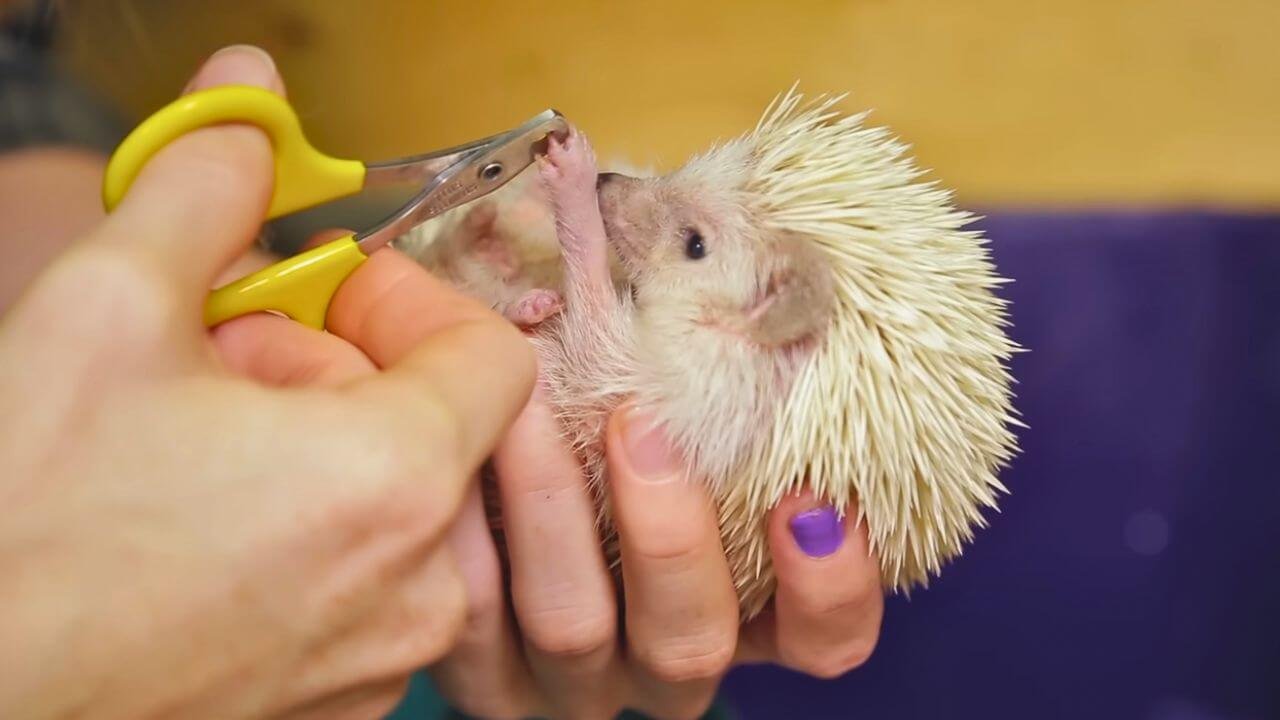In this article, we will explain how to trim hedgehog nails. All you need is a little practice, patience, and the appropriate instruments and technique. We’ll take you step-by-step through this procedure so you may become a more confident hedgehog nail cutter.
It can be challenging to trim nails, particularly when a hedgehog isn’t cooperating. Consider cutting the nails on a quill bundle that is hissing. not a simple undertaking!
But before you read any more, make sure to seek guidance from a trustworthy hedgehog breeder or your veterinarian. Your best option is to ask a professional if, even after reading this essay, you still don’t feel comfortable cutting your little hedgehog’s nails.
Hedgehog Nails
One area of a hedgehog that frequently requires your assistance is the toenails, which should be clipped since they may become rather long. With a pair of human nail clippers, a hedgehog’s nails can be cut most easily. After he has calmed down, cuts his nails. Even though your hedgehog is obstinate, have patience.
Don’t cut his nails too short when you trim them. When trimming your hedgehog’s nails, be careful not to cut into the quick, pink section of the nail that is loaded with blood, as this can result in bleeding.
Why Do I Need to Trim My Hedgehog’s Nails?
You must cut your hedgehog’s nails because it is a pet, not a wild animal, and is housed in a separate habitat. If they don’t become too long, your hedgehog will suffer since they will find it harder to walk around with long nails. Overly long nails can grow into their feet and curl, which is quite unpleasant and can lead to infections and inflammations.
They are more prone to damage and ingrown toenails in captivity since they do not have the chance to grow their nails. Long toenails can also affect their locomotion and make it difficult for them to hold onto live prey, like bouncing crickets.
How Often Should I Trim My Hedgehog’s Nails?
The hedgehog determines this. It happens twice a month for some people, and more or less frequently for others. Just make sure they aren’t too long. The nails on the backs of the foot typically grow faster. Hedgehogs vary in their possession of dewclaws. Generally speaking, these nails don’t grow very quickly, so you don’t need to cut them very often—if at all.
Materials Required to Trim Hedgehog Nails
The supplies that are required to trim the hedgehog nails are given below:
- Nail clippers for pets or small animals
- Cornstarch or styptic powder (for possible bleeding)
- A tiny blanket or towel to hold your hedgehog
- Sweets to thank your hedgehog for helping out
- Use a flashlight or magnifying lens to assist locate the fast
- After trimming, use an emery board or nail file to smooth any uneven edges.
Handling Your Hedgehog
You must first learn how to manage your little hedgie correctly before you can learn how to cut his nails.
- To prevent your fingers from becoming stuck in his prickly armor should he abruptly curl up, avoid tucking them beneath his belly. Rather, maintain an open hand with your palms toward the hedgehog’s stomach.
- Remove all potential for falls. Put yourself on a bed or close to the floor for your initial manipulations. Thus, your pet won’t run the risk of hurting himself if he falls from a height and you are taken aback by his quick reflexes.
- Recognize that the hedgehog sees solely in two dimensions, or without perspective, due to its weak vision. He can throw himself down from a high piece of furniture without realizing he is so high because it may seem like the floor is level.
- Avoid attempting to stretch him if he curls up into a ball since you will hurt him more than help. Instead, gently massage his back in circular strokes to release tension, which will encourage him to extend his head. Alternatively, you might dab a few drops of warm water onto his forehead.
- When your hedgie is in his cage, avoid petting him as he may feel frightened by a hand approaching from above. Remove him so he has a better view of you.
- Give him ample time to wake up before speaking to him in a calm tone to help him get used to it.
Identifying the Nail Quick
It’s important to comprehend the structure of your hedgehog’s nails before attempting to discover the nail fast. For reliable identification, a quiet atmosphere and sufficient lighting are prerequisites. Furthermore, taking your time and using a delicate technique might help guarantee a positive nail-trimming experience.
Knowing the Anatomy: The blood vessel and nerve within the nail is called the quick. It is seen as a pinkish patch inside the nail.
Lightning: Make Use of Proper Lighting Make sure you have adequate illumination so you can see the quick and the nail properly.
Gentle Nail Extension: To make the quick easier to view, gently press on the toe pad. This will stretch the nail.
Examine the Nail Structure: The darker, pinker area within the transparent portion of the nail is usually the quickest.
Exercise Caution: To prevent cutting into the quick, which can cause pain and bleeding, exercise caution when trimming close to it. Start cautiously by first merely trimming the nail’s tip to prevent cutting too near to the quick.
How To Safely Trim Your Hedgehog’s Nails
Human-like nails are present on hedgehogs. Hedgehogs vary in how often they need their nails clipped; some need it every few weeks, while others wear them down while playing. Although the nails on the back of the foot rarely curl under, excessively long nails can make walking challenging.
Thus, the following steps will help you get going:
Step-1
You will need to gather some supplies first. A pair of tiny nail clippers made especially for cutting the nails of animals is required. Additionally, a soft towel or piece of fabric to wrap your hedgehog in will keep it calm and motionless.
Step-2
Next, examine the nails on your hedgehog. You might want to concentrate on the front paws’ nails first because they often grow in the quickest. The quick, or pink, portion of the nail should never be trimmed, and it should be reasonably short.
Step-3
When you’ve determined how much trimming is necessary, carefully wrap the towel or cloth around the hedgehog. This will assist in keeping them motionless as you work. While holding their foot steady with one hand, delicately trim the tips of their nails with the other.
Step-4
Cut off the tip of the nail with small manicure scissors or nail clippers, taking care not to cut too close to the quick (the pink area of the nail). Your hedgehog may experience discomfort and may start bleeding as a result. If your hedgehog becomes fidgety, you can alternate paws or cut all the nails on one before going on to the other.
Step-5
If you’re unsure about the exact amount of nail to cut, err on the side of caution and remove a small portion at a time. If extra trimming is needed, it’s simpler to go back and do so than it is to attempt to repair a damaged nail. Your hedgehog will look snazzy in no time after you get the hang of it with a little practice! Give your hedgehog a reward and some extra love when you’re done pruning; they’ve been quite understanding!
Dealing with Potential Bleeding
When clipping a hedgehog’s nails, handling any possible bleeding needs to be done coolly and collectedly. To comfort your pet if you inadvertently clipped the nail too short and it begins to bleed, you must maintain composure. Remain as calm as possible while you apply the cornstarch or powder to your hedgehog.
Offer them goodies to divert their attention from any discomfort they may be experiencing, as well as consoling words and soft touches. Keep a close eye on the nail to make sure the bleeding stops. If bleeding persists or if you’re uncertain about how to proceed, don’t hesitate to seek advice from a veterinarian for further assistance and guidance.
Post-Trimming Care and Comfort
It’s crucial to provide your hedgehog comfort and make sure they’re safe after you’ve clipped their nails. First, return your hedgehog to its cage or environment gradually so that it may acclimate and unwind. Give them a comfortable place to curl up with bedding so they feel secure. After the cutting session, keep an eye out for any indications of tension or discomfort in your hedgehog.
Furthermore, watch how they move to make sure they’re not favoring any one paw and that they’re moving around comfortably. Provide your hedgehog with more care and comfort if they appear uneasy. Lastly, give their hedgehog their favorite food as a thank you for cooperating with the nail-trimming procedure. After a session of nail clipping, your hedgehog will soon revert to its happy and contented self with the right care and attention.
Tips for Successful Nail Trimming
Follow these tips for successful nail trimming for the hedgehogs:
- To keep your hedgehog’s nails from getting too long, set up a regular timetable for cutting them.
- Before trying to cut your hedgehog’s nails, get them comfortable to have their feet touched if they aren’t used to having their nails clipped.
- If at all feasible, ask a friend or member of your family to help you hold your hedgehog firmly and gently while it is being trimmed.
- In between nail-cutting procedures, make sure to periodically examine your hedgehog’s nails for evidence of overgrowth or jagged edges.
- Don’t be afraid to ask a veterinarian or professional groomer for help if you’re not sure how to clip your hedgehog’s nails or if it gets too freaked out while doing so.
FAQs
Q1: How often should I trim my hedgehog’s nails?
The frequency of nail trimming varies among hedgehogs, but generally, it may need to be done every few weeks. Monitor your hedgehog’s nail growth and trim them as needed to prevent them from becoming overgrown.
Q2: What if my hedgehog’s nails are too long?
If your hedgehog’s nails are excessively long, it can lead to discomfort and difficulty walking. Trim the nails carefully, avoiding cutting into them quickly. Seek guidance from a veterinarian if you’re unsure how to proceed.
Q3: Can I use regular human nail clippers to trim my hedgehog’s nails?
It’s recommended to use pet nail clippers specifically designed for small animals to ensure clean and precise cuts. Human nail clippers may not be suitable for hedgehog nails and could cause injury if not used correctly.
Q4: How do I know if I’ve trimmed my hedgehog’s nails too short?
If you accidentally cut into the quick, your hedgehog may experience discomfort and bleeding. Keep styptic powder or cornstarch on hand to help stop bleeding quickly. Monitor the nail closely and seek veterinary assistance if bleeding persists or if you’re uncertain about how to proceed.
Q5: What if my hedgehog is uncooperative during nail trimming?
If your hedgehog is not cooperating during nail trimming, try to remain patient and calm. Consider enlisting the help of a friend or family member to assist you in holding your hedgehog securely.
Conclusion
In conclusion, how to trim hedgehog nails? Learning the art of trimming hedgehog nails takes time, practice, and appropriate technique. By following a regular trimming plan and using the proper tools, you can keep your hedgehog’s nails at a safe length, avoiding discomfort and potential health problems. Prioritize your hedgehog’s comfort and, if necessary, seek expert assistance to ensure a nice grooming experience for both you and the creature.



